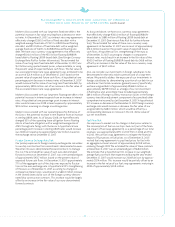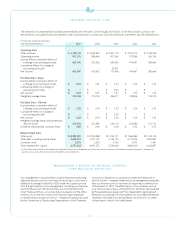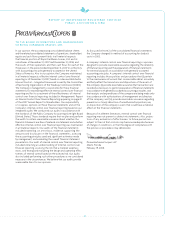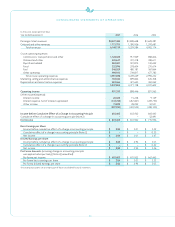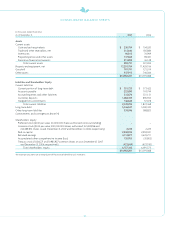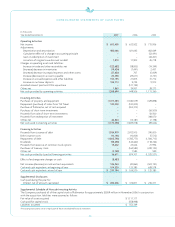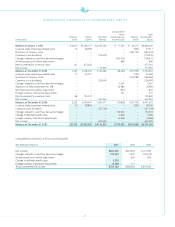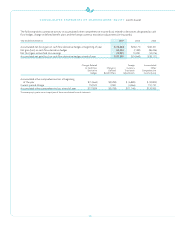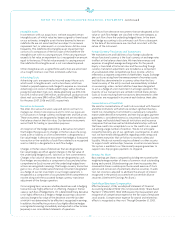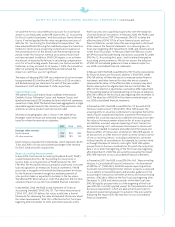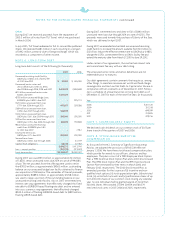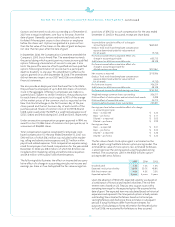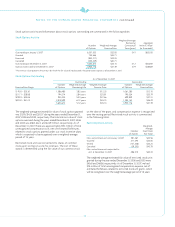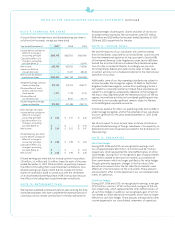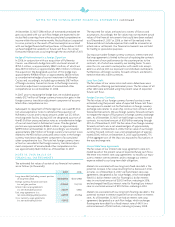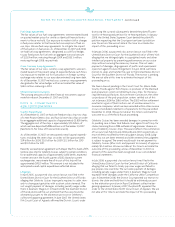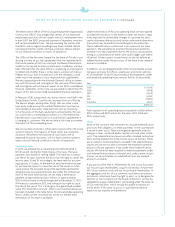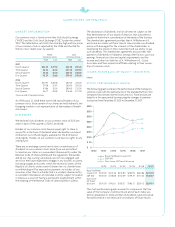Royal Caribbean Cruise Lines 2007 Annual Report Download - page 33
Download and view the complete annual report
Please find page 33 of the 2007 Royal Caribbean Cruise Lines annual report below. You can navigate through the pages in the report by either clicking on the pages listed below, or by using the keyword search tool below to find specific information within the annual report.
31
NOTES TO THE CONSOLIDATED FINANCIAL STATEMENTS continued
we used the intrinsic value method to account for stock-based
awards to our employees under APB Opinion No. 25, “Accounting
for Stock Issued to Employees,” and disclosed pro forma informa-
tion as if we had applied the fair value recognition provisions of
SFAS No. 123, “Accounting for Stock-Based Compensation.” We
have adopted SFAS 123R using the modified prospective transition
method in which we are recognizing compensation expense on
the unvested portion of the awards over the remaining vesting
period. Under this transition method, prior period results have
not been restated. In addition, SFAS 123R requires us to estimate
the amount of expected forfeitures in calculating compensation
costs for all outstanding awards. Previously, we had accounted for
forfeitures as they occurred. As of January 1, 2006, the cumulative
effect of adopting the expected forfeiture method and the
impact on cash flows was not significant.
The impact of adopting SFAS 123R was a reduction of our net income
by approximately $10.3 million and $11.3 million, or $0.05 on a basic
and diluted earnings per share basis, for each of the years ended
December 31, 2007 and December 31, 2006, respectively.
Segment Reporting
We operate four cruise brands, Royal Caribbean International,
Celebrity Cruises, Pullmantur Cruises, and Azamara Cruises, and
launched a new brand, CDF Croisières de France, which will commence
operations in May 2008. The brands have been aggregated as a single
reportable segment based on the similarity of their economic char-
acteristics as well as products and services provided.
Information bygeographic area is shown in the table below.
Passenger ticket revenues areattributed to geographic areas
based on where the reservation originates.
2007 2006 2005
Passenger ticket revenues:
North America
70%
82% 85%
All other countries
30%
18% 15%
North America includes the United States which represents 63.4%,
75.8%and 78.9% of total consolidated passenger ticket revenue
for 2007, 2006 and 2005, respectively.
Recent Accounting Pronouncements
In June 2006, the Financial Accounting Standards Board (“FASB”)
issued Interpretation No. 48, “Accounting for Uncertainty in
Income Taxes, an interpretation of FASB Statement No. 109”
(“FIN 48”). FIN 48 clarifies the accounting for uncertainty in income
taxes recognized in an enterprise’s financial statements. FIN 48
prescribes a recognition threshold and measurement attribute
for the financial statement recognition and measurement of
atax position taken or expected tobe taken in the tax return.
Weadopted FIN 48 on January 1, 2007. The adoption did not have
amaterial impact on our 2007 consolidated financial statements.
In September 2006, the FASB issued Statement of Financial
Accounting Standard (“SFAS”) No. 157, “Fair Value Measurements”
(“SFAS 157”). SFAS 157 defines fair value, establishes a formal
framework for measuring fair value and expands disclosures about
fair value measurements. SFAS 157 is effective the first fiscal year
beginning after November 15, 2007, and interim periods within
that fiscal year, and is applied prospectively with the exception
of certain financial instruments. In February 2008, the FASB issued
aFASB Staff Position (“FSP”) that amends SFAS 157 to delay the
effective date of SFAS 157 for all non-financial assets and non-
financial liabilities, except those that are recognized or disclosed
atfair value in the financial statements on a recurring basis to
fiscal years beginning after November 15, 2008, and interim periods
within those fiscal years. In February 2008, the FASB also issued
an FSP that would exclude leasing transactions accounted for under
SFAS No. 13, “Accounting for Leases,” and its related interpretive
accounting pronouncements. We do not expect the adoption
of SFAS 157 and related guidance to have a material impact on
our 2008 consolidated financial statements.
In February 2007, the FASB issued SFAS No. 159, “The Fair Value Option
for Financial Assets and Financial Liabilities” (“SFAS 159”). Under
SFAS 159, entities will have the option to measure certain financial
instruments and other items at fair value that are not currently
measured at fair value. At the effective date, a company may elect
the fair value option for eligible items that exist at that date. The
effectof this election is reported as a cumulative effect adjustment
tothe opening balance of retained earnings in the year of adoption.
SFAS 159 is effective the first fiscal year beginning after November 15,
2007. The adoption of SFAS 159 will not have a material impact on
our 2008 consolidated financial statements.
In December 2007, the FASB issued SFAS No. 141 (revised 2007),
“Business Combinations,” (“SFAS 141R”). SFAS 141R requires the
acquiring entity in a business combination to recognize the full fair
value of assets acquired and liabilities assumed in the transaction
whether full or partial acquisition, establishes the acquisition-date
fair value as the measurement objective for all assets acquired
and liabilities assumed, requires expensing of most transaction
and restructuring costs, and requires the acquirer to disclose all
information needed to evaluate and understand the nature and
financial effectof the business combination. SFAS 141R applies to
all transactions or other events in which an entity obtains control
of one or more businesses, including combinations achieved
without transfer of consideration, for example, by contract alone
or through the lapse of minority veto rights. SFAS 141R applies
prospectively to business combinations for which the acquisition
date is on or after the beginning of the first fiscal year beginning
after December 15, 2008. We are currently evaluating the impact
SFAS 141R mayhave on our consolidated financial statements.
In December 2007, the FASB issued SFAS No. 160, “Noncontrolling
Interests in Consolidated Financial Statements – An Amendment
of ARB No.51,” (“SFAS 160”). SFAS 160 requires reporting entities
to present noncontrolling (minority) interests as equity as opposed
to as a liability or mezzanine equity and provides guidance on the
accounting for transactions between an entity and noncontrolling
interests. SFAS 160 is effective the first fiscal year beginning after
December 15, 2008, and interim periods within that fiscal year.
SFAS 160 applies prospectively as of the beginning of the fiscal
year SFAS 160 is initially applied, except for the presentation and
disclosure requirements which are applied retrospectively for
all periods presented subsequent to adoption. We are currently
evaluating the impact SFAS 160 may have on our consolidated
financial statements.


